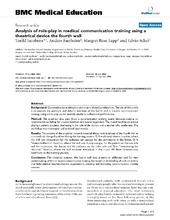Analysis of role-play in medical communication training using a theatrical device the fourth wall
Peer reviewed, Journal article

Åpne
Permanent lenke
https://hdl.handle.net/1956/1904Utgivelsesdato
2006-10-14Metadata
Vis full innførselSamlinger
Originalversjon
https://doi.org/10.1186/1472-6920-6-51Sammendrag
Background: Communication training is a central part of medical education. The aim of this article is to explore the positions and didactic functions of the fourth wall in medical communication training, using a role-play model basically similar to a theatrical performance. Method: The empirical data stem from a communication training model demonstrated at an international workshop for medical teachers and course organizers. The model involves an actress playing a patient, students alternating in the role of the doctor, and a teacher who moderates. The workshop was videotaped and analyzed qualitatively. Results: The analysis of the empirical material revealed three main locations of the fourth wall as it moved and changed qualities during the learning session: 1) A traditional theatre location, where the wall was transparent for the audience, but opaque for the participants in the fiction. 2) A "timeout/reflection" location, where the wall was doubly opaque, for the patient on the one side and the moderator, the doctor and the audience on the other side and 3) an "interviewing the character" location where the wall enclosed everybody in the room. All three locations may contribute to the learning process. Conclusion: The theatrical concept ‘the fourth wall’ may present an additional tool for new understanding of fiction based communication training. Increased understanding of such an activity may help medical teachers/course organizers in planning and evaluating communication training courses.